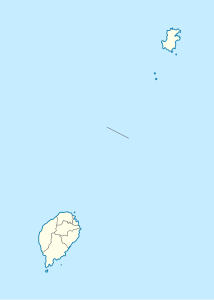geo.wikisort.org - Insel
Príncipe (portugiesisch für „Fürst“, „Prinz“), deutsch Prinzeninsel, ist die nördlichere der beiden Hauptinseln von São Tomé und Príncipe. Sie bildet gleichzeitig mit umliegenden kleineren Inseln die Autonome Region Príncipe (seit dem 29. April 1995[1]) sowie den deckungsgleichen Distrikt Pagué mit der Hauptstadt Santo António.
| Príncipe | ||
|---|---|---|
 | ||
| Gewässer | Golf von Guinea | |
| Geographische Lage | 1° 37′ N, 7° 24′ O | |
|
| ||
| Länge | 19,3 km | |
| Breite | 10,6 km | |
| Fläche | 136 km² | |
| Höchste Erhebung | Pico do Príncipe 928 m | |
| Einwohner | 7344 (2012) 54 Einw./km² | |
| Hauptort | Santo António | |
 | ||
Der Flughafen Príncipe liegt im Norden der Insel. Die principensische Sprache, die ursprüngliche Sprache der Insel, ist vom Aussterben bedroht und wird weitgehend durch die standardportugiesische Sprache verdrängt.
2012 wurde die Insel in die Liste der UNESCO-Biosphärenreservate aufgenommen.
Geographie
Die Insel liegt äquatornah, westlich von Afrika im Golf von Guinea, etwa 150 km nordnordöstlich der Insel São Tomé. Die Fläche der Insel beträgt 136 km², die der Autonomen Region 142 km² (einschließlich der zur Autonomen Region gehörenden Nachbarinseln). Davon gehören 85 km² zum Parque Natural Obô do Príncipe. Der Pico do Príncipe ist mit 948 m die höchste Erhebung der Insel. Es leben etwa 5.000 Menschen auf Príncipe.
Geschichte
Als Entdecker der Insel gilt der portugiesische Seefahrer João de Santarém. Er handelte im Auftrag des Kaufmanns Fernão Gomes, welcher vom portugiesischen König Alfons V. das Recht erworben hat, jährlich 100 Leguas afrikanischer Küste im Namen der portugiesischen Krone, jedoch auf eigene Kosten, zu erkunden. Er entdeckte Principe am 17. Januar 1472. Zunächst wurde die Insel Santo António oder auch Antão genannt, 1502 erhielt sie ihren heutigen Namen.
Arthur Stanley Eddington gelang auf der Insel 1919 während einer Sonnenfinsternis die experimentelle Bestätigung der Allgemeinen Relativitätstheorie.
Fauna
Folgende Vogelarten sind auf Príncipe endemisch: der Príncipezwergfischer (Alcedo nais), der Prinzendrossling (Horizorhinus dohrni), der Hartlaubnektarvogel (Anabathmis hartlaubii), der Silberbrillenvogel (Speirops leucophaeus), der Prinzenweber (Ploceus princeps), der Prinzenglanzstar (Lamprotornis ornatus), die Príncipe-Drossel (Turdus xanthorhynchus) und die Príncipe-Zwergohreule (Otus bikegila).[2]
Kleine Inseln
Gemeinden
- Santo António (Einwohner: 1.156)
Weblinks
Nachweise
- Ana Maria Luciano Barreira: Cooperação Descentralizada Príncipe – Portugal: Eficiência da Existência de Redes de Cooperação, Universidade Técnica de Lisboa 2010, S. 42–43
- Artenvielfalt: »Geist des Waldes« manifestiert sich. Abgerufen am 3. November 2022.
На других языках
- [de] Príncipe
[en] Príncipe
Príncipe is the smaller, northern major island of the country of São Tomé and Príncipe lying off the west coast of Africa in the Gulf of Guinea.[2] It has an area of 142 square kilometres (55 sq mi) (including offshore islets) and a population of 7,324 at the 2012 Census;[3] the latest official estimate (at May 2018) was 8,420.[1] The island is a heavily eroded volcano speculated to be over three million years old, surrounded by smaller islands including Ilheu Bom Bom, Ilhéu Caroço, Tinhosa Grande and Tinhosa Pequena. Part of the Cameroon Line archipelago, Príncipe rises in the south to 947 metres at Pico do Príncipe.[4] The island is the main constituent of the Autonomous Region of Príncipe, established in 1995, and of the coterminous district of Pagué.[es] Isla de Príncipe
La isla de Príncipe es la más pequeña de las dos islas principales de Santo Tomé y Príncipe. Tiene un área de 136 km² y una población de 8000 personas. Su altura máxima es el pico de Príncipe (948 m), localizado al sur de la isla, y que forma parte del área forestal del parque natural Obo. El norte y centro de la isla fueron antiguas plantaciones que ahora están siendo reforestadas. La isla abarca la provincia del mismo nombre, y que a su vez se subdivide únicamente en el distrito de Pagué.[fr] Principe (île)
Principe, aussi appelée île du Prince sous une forme peu usitée, en portugais Príncipe ou Ilha do Príncipe, est une île d'Afrique formant avec l'île de São Tomé la République de Sao Tomé-et-Principe. Elle constitue à titre principal une province et le district de Pagué de ce pays.[it] Príncipe
Príncipe è la più piccola delle due principali isole dello Stato di São Tomé e Príncipe.[ru] Принсипи
При́нсипи (порт. Príncipe) — остров в Гвинейском заливе Атлантического океана. Второй по величине остров, входящий в состав государства Сан-Томе и Принсипи.Другой контент может иметь иную лицензию. Перед использованием материалов сайта WikiSort.org внимательно изучите правила лицензирования конкретных элементов наполнения сайта.
WikiSort.org - проект по пересортировке и дополнению контента Википедии
